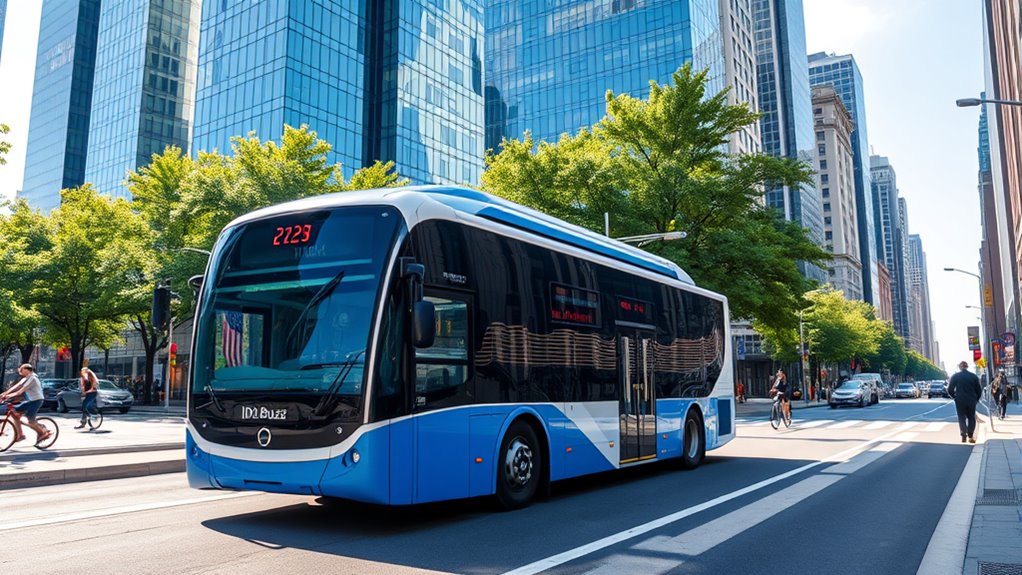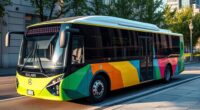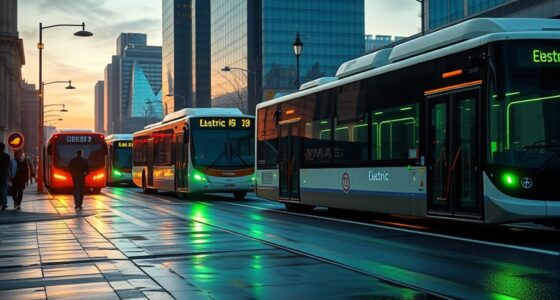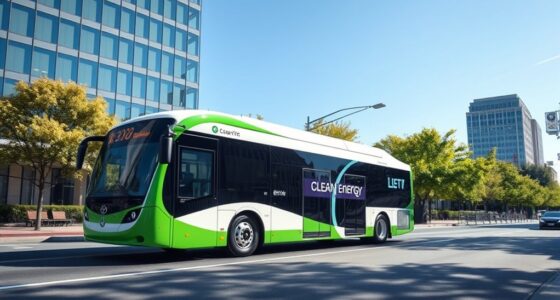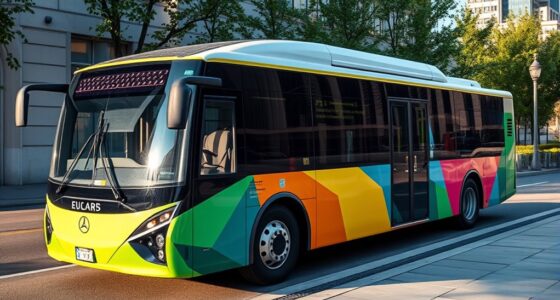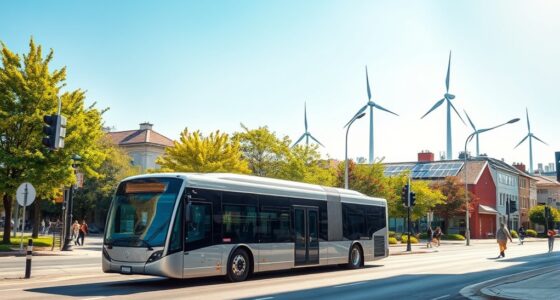Electric buses like the ID.Buzz help cut urban pollution by replacing diesel engines with zero-emission electric power, eliminating exhaust and reducing pollutants. They improve air quality, support healthier communities, and lower greenhouse gases, especially when powered by renewable energy. Plus, advances in battery and fast-charging technology enhance efficiency and extend vehicle range. If you want to see how these innovations drive cleaner cities and healthier lives, there’s more to explore.
Key Takeaways
- Electric buses eliminate diesel exhaust emissions, significantly reducing particulate matter and air pollutants in urban areas.
- They cut greenhouse gas emissions, supporting climate change mitigation and improving overall urban air quality.
- Advanced battery and energy management systems enable efficient operation, lowering pollution caused by energy generation.
- Fully electric fleets decrease reliance on fossil fuels, leading to cleaner, healthier city environments.
- Supporting infrastructure and green urban planning amplify pollution reduction benefits in cities.
Zero Emission Technologies Transform Urban Transit
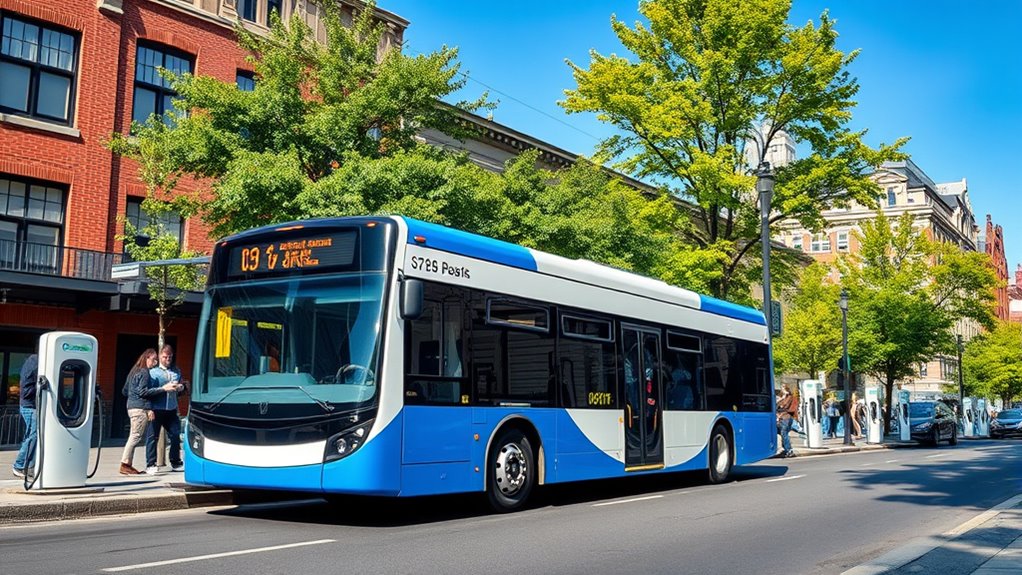
Zero emission technologies are revolutionizing urban transit by providing cleaner, more efficient alternatives to traditional fossil fuel buses. Advances in battery and fuel cell systems now deliver better power, longer range, and higher efficiency, making these buses practical for daily operation.
Zero emission tech transforms urban transit with cleaner, efficient, and practical bus solutions.
Transit agencies are adopting both battery electric and fuel cell buses, each suited to different needs within urban environments. These vehicles help reduce greenhouse gases, with each bus eliminating about 1,690 tons of CO2 over its 12-year lifespan.
Cost-wise, zero-emission buses are becoming more competitive when considering total lifetime expenses. Implementing these technologies requires integrating new infrastructure and updating workforce skills. Additionally, innovations in battery technology are crucial for improving energy storage capabilities and extending vehicle range. Battery efficiency improvements are also vital for maximizing performance and reducing overall costs. Furthermore, ongoing research into energy management systems enhances the integration of these technologies into existing transit networks.
Renewable energy innovations are also supporting the deployment of electric buses by providing cleaner electricity sources, further reducing their environmental impact. As a result, cities are shifting toward cleaner, quieter, and more sustainable transit systems, paving the way for a greener future.
Impact on Air Quality and Public Health
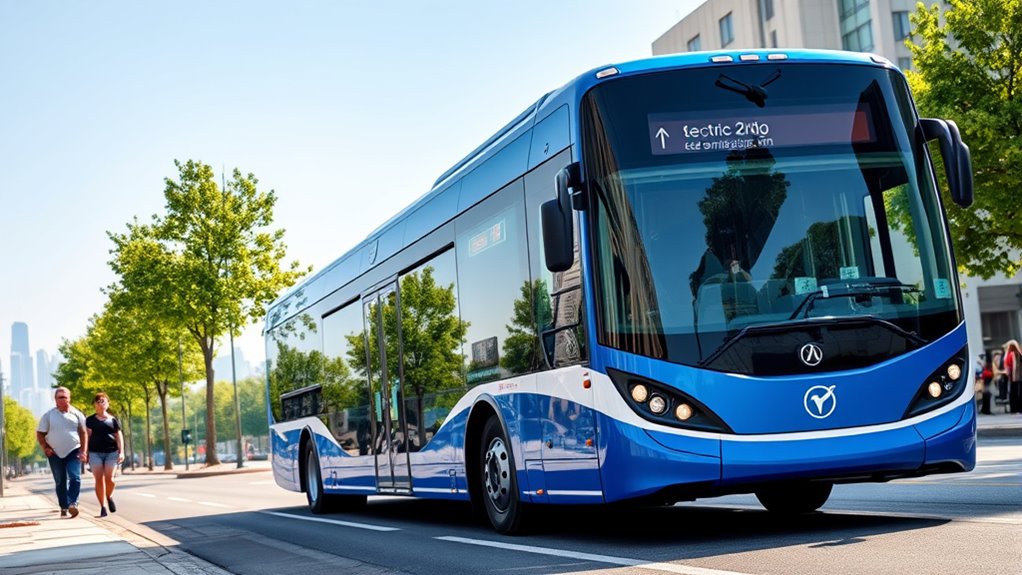
Electric buses notably improve urban air quality by reducing harmful pollutants that contribute to smog and health issues. They cut particulate matter and eliminate diesel exhaust, which are major sources of air pollution. Using electricity, these buses produce far fewer greenhouse gases, helping lower ground-level ozone formation. As a result, communities experience healthier air, reducing respiratory problems like asthma and lowering PM2.5-related deaths. Cleaner air also means fewer new asthma cases in children and reduced healthcare costs. Electric buses promote better public health by decreasing pollution’s health impacts, creating a safer environment for urban residents. They support enhanced air quality monitoring and raise awareness about pollution’s health impacts. Additionally, understanding credit card terms is essential for financial literacy, which can help individuals manage the economic aspects of adopting new transportation technologies. Incorporating electric vehicle infrastructure into city planning further accelerates the transition to cleaner transportation. Furthermore, advancements in electric vehicle technology continue to improve the efficiency and affordability of electric buses. Overall, electric buses contribute profoundly to healthier, more livable cities.
Contribution to Climate Change Mitigation
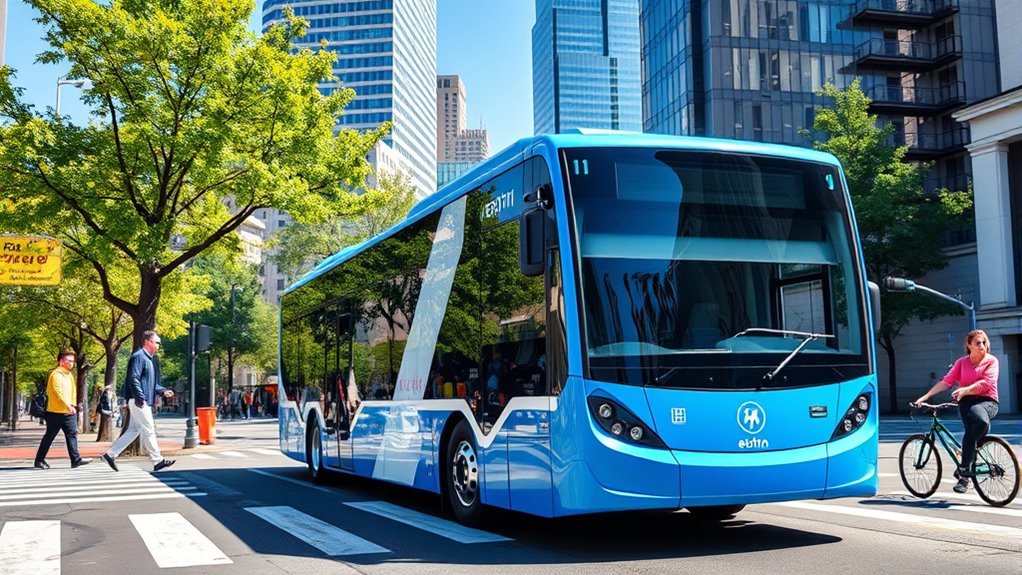
As electric buses replace their diesel counterparts, they play a significant role in combating climate change by drastically reducing greenhouse gas emissions. They produce zero tailpipe emissions, eliminating particulate matter, nitrogen oxides, and hydrocarbons. Organic and natural juices are an example of natural products that contribute to healthier lifestyles and sustainable practices. Fully electrifying U.S. transit buses could cut up to 2 million tons of annual GHGs, with each bus saving about 181 metric tons of CO2 over its lifetime compared to diesel. Cities like São Paulo could save over 30,000 ktCO2e by 2050 through full fleet electrification. When powered by renewable-heavy grids, these buses further lower emissions, especially with smart charging and grid improvements. Fleet-wide electrification, particularly targeting older diesel buses, can avoid millions of tons of CO2, supporting global efforts to meet climate change mitigation targets and decarbonize urban transport systems. Incorporating renewable energy sources into power grids enhances the environmental benefits of electric buses even further.
Economic Advantages of Electric Bus Adoption
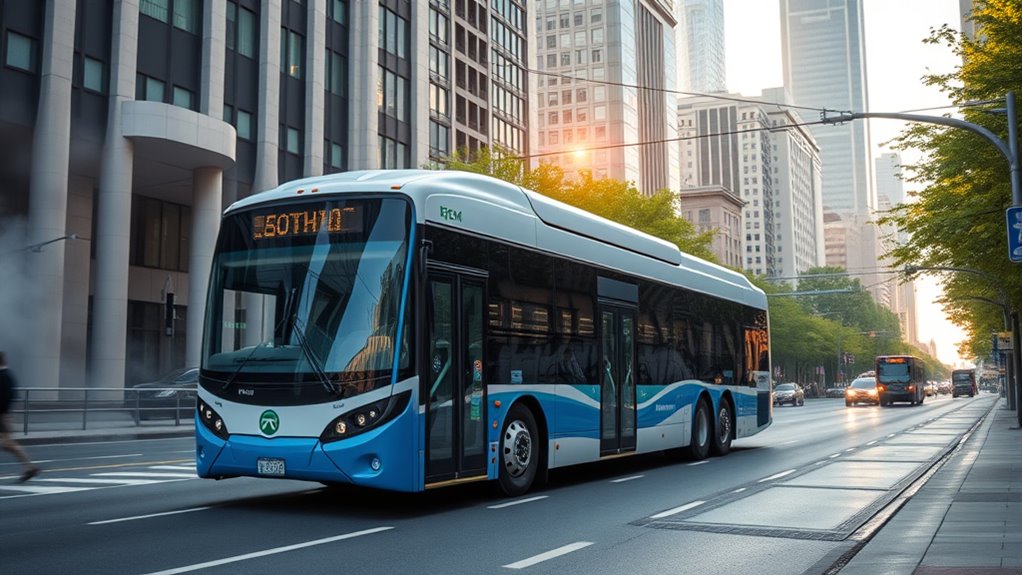
Switching to electric buses offers substantial economic benefits for transit agencies and local communities alike. You’ll notice significant cost savings, as electricity is roughly 2.5 times cheaper than diesel, cutting operational costs by about half.
Maintenance expenses drop almost 50%, saving you up to $50,000 over five years per bus, with lifetime savings reaching $400,000. Electricity prices are more stable than fossil fuels, reducing financial risks from geopolitical events. Moreover, the development of robust safety measures ensures the reliability and security of electric bus systems. Additionally, investing in renewable energy sources can further decrease operational costs and environmental impact.
The electric bus industry creates jobs and stimulates local economies through infrastructure investments and domestic production. Although initial infrastructure costs are high, long-term savings and incentives make the switch economically smart. Infrastructure investments can also lead to improved urban development and connectivity.
Implementing efficient payment solutions can further streamline operations and improve service delivery for transit agencies adopting electric buses. This *shift* not only reduces expenses but also strengthens economic resilience and promotes community growth.
Technological Innovations Enhancing Efficiency
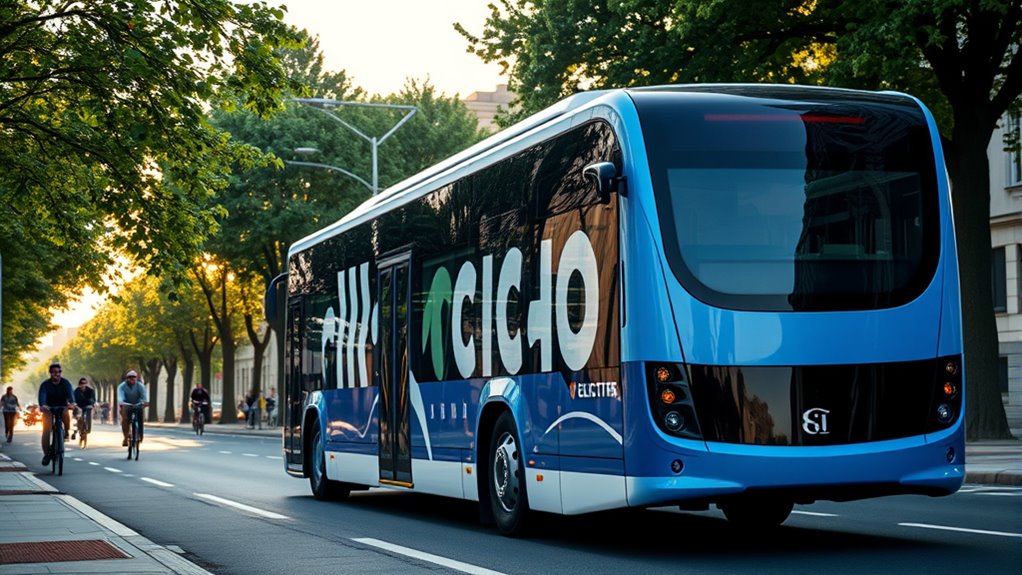
Recent technological innovations have considerably boosted the efficiency of electric buses, making them more viable for urban transit. Advances like solid-state and lithium-sulfur batteries now offer higher energy density and longer lifespans, letting buses travel farther on a single charge.
Ultra-fast charging systems enable you to recharge in minutes, minimizing downtime and boosting operational efficiency. AI integration helps optimize routes and manage energy use, reducing waste.
New double-decker buses can now reach 250 miles or more, a 25% increase since 2017. Energy recovery systems, like regenerative braking, capture kinetic energy to recharge batteries during operation.
These innovations lead to reduced energy consumption, lower costs, and longer-lasting batteries, making electric buses a smarter, more sustainable choice for urban transportation.
Supporting Sustainable Urban Development
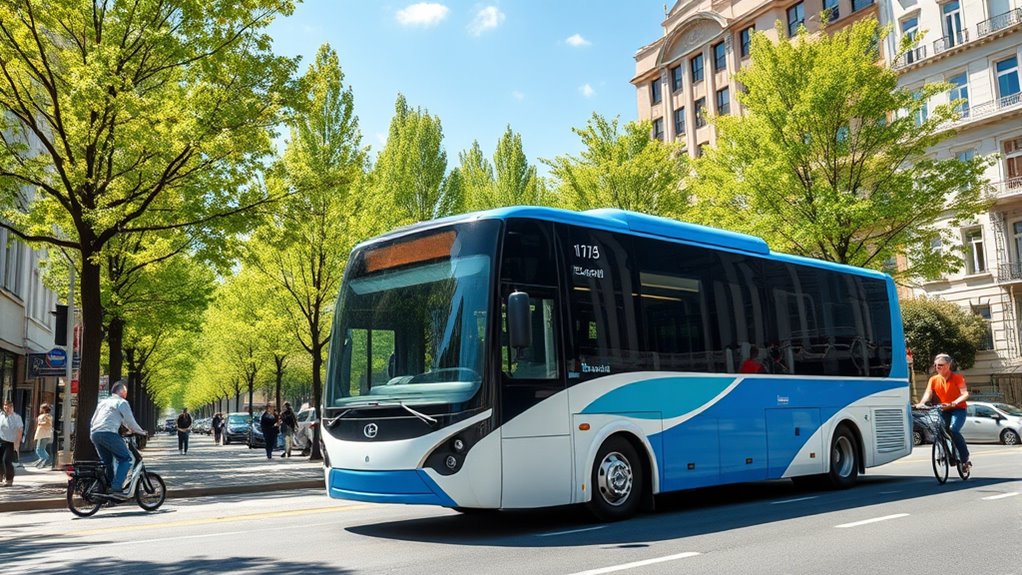
Technological advances in electric buses play a key role in supporting sustainable urban development by reducing transportation emissions. These buses enable the integration of diverse land uses, like housing, shops, and community spaces, which cuts down on long commutes. Utilizing vertical storage solutions in related infrastructure can further optimize space and efficiency in transit facilities. When combined with public transit options, they lessen reliance on private vehicles, further lowering air pollution. Green infrastructure, such as parks and green roofs, improves air quality and counters urban heat. Designing streets that prioritize pedestrians and cyclists encourages active travel. Engaging local communities ensures developments meet residents’ needs while promoting sustainability. Additionally, incorporating Hyundai Tuning enhancements into urban transit vehicles can optimize performance and efficiency. This approach supports compact infill development, reducing urban sprawl and preserving natural habitats. Promoting urban greening strategies can further enhance environmental benefits and improve overall quality of life. Moreover, adopting electric vehicle integration in urban planning can streamline transportation networks and maximize sustainability efforts. Together, these strategies foster healthier, more efficient cities that balance growth with environmental conservation.
Frequently Asked Questions
How Do Electric Buses Compare in Lifespan to Traditional Diesel Buses?
You might wonder how electric buses compare to diesel buses in lifespan. Typically, electric buses have a similar planned lifespan of about 10 years, but their batteries can last up to 700,000 km, which may extend their service life with upgrades.
Diesel buses are known for durability and high mileage. Overall, electric buses can match or even surpass diesel buses in longevity, especially with proper maintenance and battery management.
What Are the Challenges in Expanding Electric Bus Charging Infrastructure?
You’re facing several challenges when expanding electric bus charging infrastructure. You need substantial upfront investment and careful planning for space, grid capacity, and route alignment.
Managing charging schedules without disrupting service is tricky, especially during peak hours. Limited urban space makes installing chargers difficult, and integrating infrastructure with policies and standards adds complexity.
Balancing these factors is essential to create a scalable, efficient system that supports widespread electric bus adoption.
Are Electric Buses Suitable for Long-Distance Routes or Only Urban Transit?
Imagine a bus that can travel across entire states without stopping—sounds like a dream, right? Electric buses are mainly suited for urban transit, but recent advancements push their limits toward long-distance routes.
With ranges up to 340 miles on a single charge, and improved battery tech, you can see how they’re becoming viable for longer journeys. Still, route planning and infrastructure upgrades are vital for making this a reality.
How Do Electricity Grid Demands Affect the Environmental Benefits of Electric Buses?
You might wonder how grid demands impact electric buses’ environmental benefits. When the grid relies on fossil fuels like coal, the emission reductions from electric buses decrease.
However, if your city invests in renewable energy and smart charging, you can maximize pollution cuts. Using energy storage and V2G technology helps balance demand, ensuring electric buses deliver cleaner transportation and markedly reduce urban pollution over time.
What Training Is Needed for Maintenance Staff of Electric Bus Fleets?
You might think maintenance staff need only basic skills, but they require specialized training to handle electric buses safely and effectively. You’ll need knowledge of electric vehicle systems, high voltage safety protocols, and charging infrastructure.
Certification in high voltage work is vital, along with ongoing education. By mastering these areas, you ensure safe maintenance, optimize vehicle performance, and support the broader goal of reducing urban pollution through reliable electric bus operation.
Conclusion
As you embrace electric buses like the ID.Buzz, you’re fueling a cleaner, healthier city—cutting pollution like a sharp knife through fog. These zero-emission vehicles don’t just improve air quality and public health; they also pave the way for a sustainable future. By choosing electric, you’re not only driving change but steering your community toward a greener horizon, proving that small actions can create ripples of big environmental impact.
